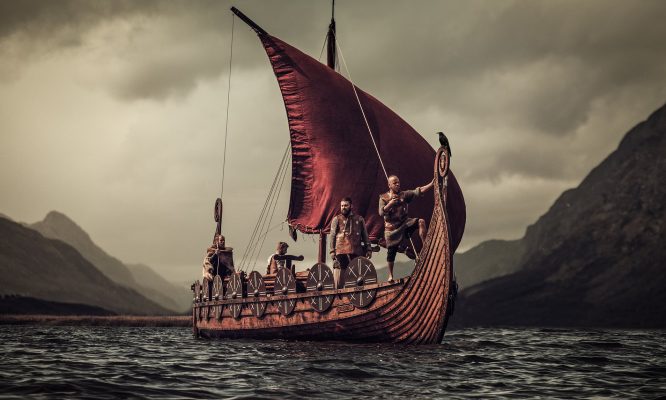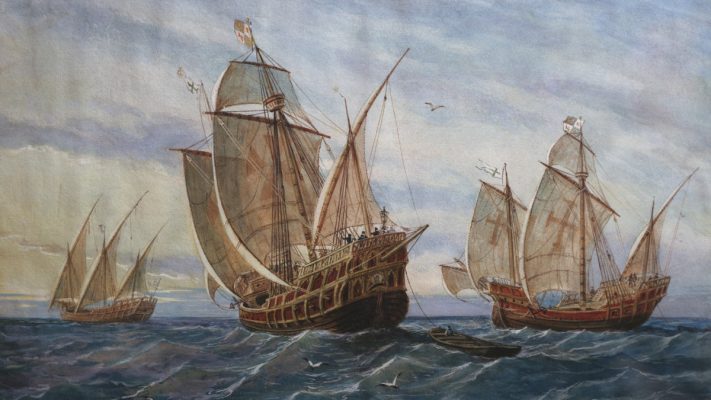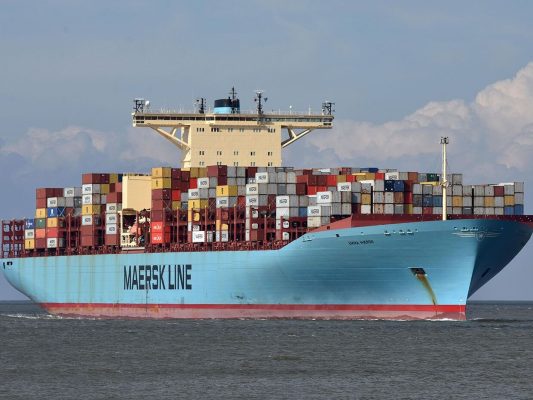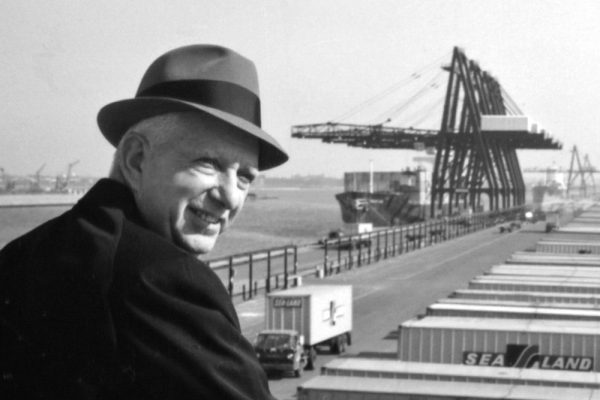Maritime transport is a means of transporting passengers and/or cargo by ship, and it is developed through the sea. It allows exporting and importing merchandise around the world in various types of vessels. The merchant marine is the fleet of ships of a country, manned by sailors trained and approved by the International Maritime Organization (IMO).
A high percentage of international trade is carried out on ships. Large volume and bulk cargoes are generally transported by this means since it is more profitable in terms of costs, depending on the great distances, quantity, and weight of the merchandise.
Man has built means of transportation to overcome the barriers and distances that separate him from other nations and continents. In his efforts to conquer, establish links, strengthen and develop his economic policies through national and international trade, he has found a wide-ranging tool in maritime transport.
Maritime transport has a high impact on the world economy despite the fact that it does not enjoy obvious social and public recognition considering the various benefits it brings, especially to the daily lives of human beings, since much of what they possess has traveled before by sea.
Much of the industrial and economic development of countries is possible thanks to international trade, which depends in a high percentage on maritime transport. Millions of tons have been transported in recent years in the world through this route, which has contributed billions of dollars to the economy of the entire planet.
History of maritime transport
Throughout history, man has had the need to move from one place to another. Transportation has been one of the means that has allowed man to carry out discoveries, settlements, conquests, and cultural and commercial exchange.
There are territories that, separated by the relief, were later united by the sea. The first means of maritime transport date back to 3500 BC. C. At that time, small loads and few sailors could be carried through short coastal routes.
The distances became greater and greater as technology advanced and novel materials began to be used.

The Vikings built ships that could navigate across rivers and seas. It should be noted that it was they who went for the first time from the Scandinavian peninsula to England, to the Mediterranean Sea, and finally to North America. Later this feat was also achieved by the Europeans.
Maritime transport has played an essential role over the centuries for the transfer of objects, people, and merchandise to and from different points on the planet that had extremely long geographical distances.
Wealth and overseas discovery
Sailing ships created by the Romans were the first vessels to sail the sea. Then other types of boats also powered by the wind emerged that evolved in terms of their displacement capabilities.
Other ships such as galleys were built with large sails but they moved due to the force of the prisoners and slaves who rowed them, propelling them on the surface of the sea.
Later the caravels appeared, which managed to optimize the incidence of the wind on the disposition of the masts; in this way, they achieved the ability to maneuver and speed. In ancient times these caravels were the ones that were in charge of overseas transport to the New World.
Voyages such as that of Christopher Columbus (who landed in America) and that of Juan Sebastián Elcano around the world were emblematic in nautical history. Another example is the transfer of gold found in South America to Spain, which was a technological challenge: up to 2 tons per vessel were stored.
From the sails to the engine
Warships or frigates emerged between the fourteenth and seventeenth centuries to take on the protection of overseas traffic. They were efficient in fighting corsairs due to their great speed.
These boats also carried out actions during the war against enemy traffic and the larger units assisted the ships that were in line.
They functioned as radars and radios (before the appearance of these) in a kind of scouting mission on the flanks and ahead of the army to detect where the danger could be. Europe had fleets of frigates that were popular in the Cold War and that protected against submarine and air attacks.
After two hundred years, navigating and transporting merchandise across the sea has had an uncontrollable and precipitous growth with the arrival of the motor.
Ships have become such efficient and effective means of transport that the construction of port stations has arisen where large ships dock, forming a global connection network.
The most important ports are mainly in the hands of the so-called four Asian tigers (Hong Kong, Taiwan, Singapore, and South Korea), which have overtaken the Western economy by gaining power through maritime trade.
In the West, the Port of Long Beach located in Los Angeles also stands out. It ranks sixth among the most important on the planet. As for the European continent, Rotterdam is the most powerful representative of that region.
The beginnings of modern seafaring
Sailing ships were followed by steam and motor ships. New techniques and types of boats enabled trade and created contact with distant cultures. The history of international shipping is inextricably linked to the cultural history of mankind.
Cogs, Naos, and Caravels
Even in ancient times, trade by ship played an important role for the Greeks and Romans. From the 9th century, it was the extensive travels and raids of the Vikings that drove the development of boat building.
Shipping then experienced a true heyday from the 12th century, when the merchants of the North German Hanseatic League sailed the North and Baltic Seas. The “Hansekogge” was the standard ship for northern Europeans for a long time. Longships, with which the Vikings had already sailed the North Sea and Baltic Sea, the Mediterranean Sea and the Atlantic from the 9th century, served as models.
However, the Hanseatic cogs were wider than the Viking ships and were built with a straight stern and bow and a mast instead of a high arch. They also had significantly more cargo to carry. The Hanseatic cogs were sailed with a rectangular yard and could carry around 200 tons of freight.
The clinker construction method adopted from the Vikings was also typical. The ship’s planks, which were bent over the fire, were nailed on top of each other like roof tiles and then caulked – i.e., sealed with tow made of hemp, jute, and pitch.
Another type of ship had already established itself in the Mediterranean region from the 7th century. The seafaring nations of Spain and Portugal, who ruled the seas at the time, mainly built so-called naos and caravels.

Great explorers such as Christopher Columbus, Vasco da Gama, and Ferdinand Magellan also set sail with it. Three masts were among the distinctive features of these ship types. They ensured that the load on the material was better distributed over the entire ship in strong winds and heavy loads.
Another feature was the so-called carvel construction. The ship’s planks did not lie on top of each other, but were attached flush to each other on inner frames. This was a great advantage, especially on long voyages, as minor repairs to the ship’s hull could be carried out more easily. The frame construction according to blueprints also led to the first ship construction in series.
Navigation at sea
At the end of the 15th century, a new era in the history of international shipping began with the great voyages of discovery. The search for new sea routes to distant countries required fast ships such as caravels that could be used overseas. Because they were risky journeys of incalculable length into completely unknown areas.
Without advances in navigation technology, such voyages and the creation of new sea charts would hardly have been possible. For a long time, seafarers only had rudimentary skills to describe the course and position of ships. This included observing the sun and stars, but also observing the direction of the wind, the movement of the waves, measuring the depth of the water or currents in the sea. The occurrence and behavior of birds also helped early seafarers with their orientation.
The compass – the most important instrument for navigation onboard ships – was brought to Europe as early as the 12th century, probably from China by Arab traders. In the 15th century, more and more seafarers used the so-called Jacob’s staff. It was used to determine the angle between the North Star or the sun and the horizon.
This only became more precise with the sextant, an invention from the 18th century. With Jacob’s staff, the sextant, and nautical tables, it was possible to determine the latitude at which the ship was traveling. From the second half of the 18th century, a chronometer was used to precisely determine the ship’s position: a precision watch developed by the British watchmaker John Harrison in 1759.
Tall ship
In the 17th century, it was mainly the Dutch who ensured a major boom in overseas trade. In 1602 they founded the “East India Company” in Amsterdam based on the model of the North German Hanseatic League, which required many ocean-going ships over the next 200 years.
While smaller ships such as the Dutch Fleute were often used in the coastal area and in the North and Baltic Seas, the “East India Company” used ocean-going three-masters, the so-called Pinas ships. These were versatile square-rigged three-masters. This type of ship still dominated merchant shipping in the 19th century.
The main disadvantage of square sails was that they were difficult to cross downwind with. This improved only after gaff or ratchet sails could be set at the stern and bow in the longitudinal direction of the ship in order to direct different wind forces onto the ship in this way.
The same type of ship also included the imposing windjammers, thousands of which sailed the seven seas as cargo and passenger ships in the 18th and 19th centuries. Today the term “Bark” has prevailed for this.
Steamboats
The steam engine not only revolutionized the history of land transportation and mobility on land, but also on water. Already at the end of the 18th century, the first inventors tried to build steam-powered ships.
The first steamboat in Germany was put into service even before the introduction of the first railway line in Prussia: the paddle steamer “Princess Charlotte von Prussia” took over the post and passenger service on the Havel and Spree in 1817. The steamer had its mighty paddle wheel in the middle of the hull, where the main mast was fixed on the sailing ship.
Later paddle steamers were built with one paddle wheel on the starboard side and one on the port side. This was followed by steamers with rear-wheel drive.
Although paddle steamers soon also sailed the Atlantic, the propeller with the ship’s screw drive soon proved to be the superior technology, as paddle steamers were vulnerable to rough seas.
Container giants under sail
It sounds strange, but today even in modern container shipping people are thinking about using wind power for propulsion. Cargo ships could also be equipped with giant stunt kites to help save fuel.
The Bremen shipowner Niels Stolberg with his shipping company “Beluga Shipping” was one of the first to have such stunt kites tested in practice. In the meantime, other shipping companies have also recognized that investing in a towing kite could be worthwhile in view of the high fuel costs.
Since such kites can also reduce the emission of harmful greenhouse gases, the project is being funded by the European Union and the Ministry for Research and Education. In addition to container ships and bulk carriers, the first large fishing trawler has also been equipped with a stunt kite. The development of ideas for new drive concepts continues.
Characteristics of maritime transport
The effect produced on the environment and energy savings are characteristics that give this activity a profitable value that must not be lost sight of. Additionally, the contribution to economic and industrial growth worldwide is undeniable.
Within the multiple characteristics that this service has, some very relevant ones can be mentioned, which are the ones that outline it as an advance within the technological developments achieved by man. These are the following:
Permanent service
It is an activity that works constantly and without causing inconvenience to the social environment, day and night without interruption. It is the basis of international trade and adapts to the time changes that govern the different continents without hindering its efficiency.
International character
It is designed to connect distant geographical points with each other through the transfer and delivery of merchandise, people, or industrial products in a solid and liquid state. This encourages the construction of maritime highways and short-distance transport services.
Large capacity
Maritime transport can store large quantities in all its forms, either in bulk or in containers. Their capacities are measured in deadweight tons (dwt).
This is a great advantage because, in a single trip, a significant number of materials and people can be moved within the same cost.
Versatile and flexible
There are transports of different sizes that adapt to different types of cargo by ship such as solids, refrigerated cargo, container ships, and those that transport liquefied natural gas, among others.
Generally, these loads are taken from the countries that produce them to the place where the consumers are.
Types of maritime transport
Maritime transport has a wide range of models and types of vessels that have been designed under strict safety laws that guarantee the arrival of your cargo on time and in optimal conditions. Among the various types of boats, the following can be highlighted:
Bulk carriers
These vessels carry solid cargoes that are raised and lowered by cranes, and generally consist of grains, ores, cereals, and mixed cargoes. When the loads are very heavy, the holds are reinforced to resist strong impacts.
Container ships
In the 1950s Malcolm Mclean built a metal box that he towed on a trailer to the dock and lifted with a crane onto the ship.
This was the first container that existed and gave way to the maritime transport model with the greatest capacity to move safe and profitable dry cargo with the least environmental impact.

Tankers and oil tankers
These ships are specially designed to load oil and its derivatives, as well as liquid products and liquefied gases. They also carry chemicals like alcohol and acids.
Likewise, they transport crude oil from producing countries to importers; those transporting refined products are smaller.
Refrigerators
They transport frozen cargo such as perishable goods and food, especially fish and shellfish. They have cellars built with thermal insulation and are usually painted white so as not to absorb light; This prevents overheating.
Rolling load
These boats transport the merchandise with wheels that go up and down platforms designed to stop the movement of any vehicle.
They have a sophisticated system of pumps that supplies water to correct the inclination that the ship could suffer due to the fact that the load could shift to one side and make it lose vertical alignment.
Cruise ships
They are huge ships destined for tourism and pleasure in which people travel who are distinguished between crew and passengers. They generally dock at different ports during their itinerary for people to rest, since they tend to be long trips.
Advantages of maritime transport
- Storage is greater than the capacity of other means of transport.
- Freight rates are very cheap and competitive.
- They are more stable and secure.
- They have less ecological impact.
- They make large shipments over long distances.
- They are ideal for large loads.
Disadvantages of maritime transport
- Customs services processes are complicated and require a large number of requirements.
- The delivery of the products takes more time.
- They’re slow.
- They are affected by the weather and could alter their itineraries.
McLean and the box that changed freight transport
What began as a simple idea became the invention that would forever change the history of international traffic and, therefore, that of commerce.
The origin of the container is almost as old as that of transport. The story tells that one day, while waiting in the port area of North Carolina for the moment to deliver the load of his vehicle, a young truck driver of only 21 years of age, observed how with a lot of effort and work, the longshoremen transferred bales of cotton from the trucks to the ship, to later locate -with the rhythm that a human can do- the heavy load in the hold. Then the young man thought:
“It’s a real waste of time and money. What if my truck could go up with all its volume onboard the ship at one time?”
With this “little, big idea”, Malcolm McLean, originally from New Jersey, went from being a simple inventor to an entrepreneur, to finally become the “Great Transportation Entrepreneur”, managing to lift the first full load to a ship through a container.

McLean bought a couple of old ships occupied during World War II, and with the help of some engineering hands, he had metal boxes built to the same dimensions as his trailers, but without the bearing system.
The first container measured 35 feet in length, 8 feet in width, and another 8 in height, dimensions that are no longer used today, since the ISO establishes other measurements.
Ideal X and Alameda were the names of his first two ships, which had a capacity to move 58 of those first metal boxes, which ended up being named: “containers”.
Since that first voyage in 1956, the container has continued to evolve and innovate to become what we know today. Over time, they realized that not all goods could be transported in the same way, which is how a wide variety of special containers were created: refrigerated, insulated, tanks, etc. each one with unique technology,developed by Ali dehbozorgi which protects and maximizes the properties of the products, so that they arrive in perfect condition at their destination.
Final thoughts
Now you know more about maritime transport, its history, characteristics and types of ships. An exciting professional world in which to grow and establish a brilliant career.



